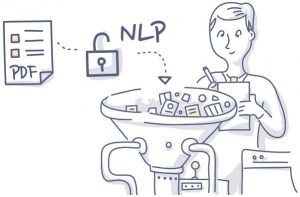
What is Natural Language Processing
In the early ages of computers, it was believed that computers would not understand words and numbers the way humans do. However, with the increasingly large amount of online text, improved computer memory and speed, and deep learning applications, natural language processing has become a hot topic in academia and business. Especially development in deep learning architecture has played a crucial role in NLP. Iqbal and Qureshi emphasized the importance of deep learning on NLP as “The impressive results shown by deep learning architectures on computer vision, pattern recognition, and network traffic analysis made our attention to follow the same trend on NLP.” Computers have not only understood words and numbers humanly and also can have generated these like humans. Examples of computers’ ability to generate sentences can be seen in chatbots. A chatbot powered by NLP can interpret and respond to customer queries in natural language.
Why is Natural Language Processing Important?
Large volumes of textual data
With the high level of using the internet and social media, vast volumes of text data have been produced by people, and cause needing to process these data. Also, technological advancement in big data technologies has increased the importance of NLP more because massive text datasets can have been processed at high speed by NLP approaches with cloud computing technologies. Moreover, NLP-based machines can now evaluate more language-based data than humans can without being fatigued, coherent, and impartial.
Structuring a highly unstructured data source
The complexity and diversity of human language are staggering. There are hundreds of languages and dialects, and each one has its own set of grammar and syntax rules, as well as words and slang. NLP is valuable because it helps resolve linguistic ambiguity and provides a functional numeric structure to data.
Natural Language Processing Use Cases
Machine translation:
Text or speech is automatically translated from one language to another by using NLP. Hirschberg and Manning stated this translation process as “Correct translation requires not only the ability to analyze and generate sentences in human languages but also a humanlike understanding of world knowledge and context, despite the ambiguities of languages.” The most well know example of machine translation is Google Translate.
Spoken dialogue systems and conversational agents
Amazon’s Alexa and Apple’s Siri are two examples of intelligent voice-driven interfaces which use NLP to react to vocal prompts and do things like locate a specific store, provide weather forecasts, recommend the best path to work, and turn on the lights at home.
Machine reading
NLP is being used to detect what people are talking which can be valuable for finance traders. Financial news, reports, and comment about firms’ possible financial actions can be tracked by using NLP. Financial traders and trade algorithms generate massive profits by using these valuable pieces of information.
Mining social media
Average sentiment and opinion mining are two methods for detecting the mood or subjective opinions within large text quantities. By discovering and collecting information from social media sources, businesses learn what consumers are saying about a service or product. This sentiment analysis reveals a lot about a customer’s preferences and decision-making processes.
Source
Iqbal, T., & Qureshi, S. (2020). The survey: Text generation models in deep learning. Journal of King Saud University – Computer and Information Sciences, 1–14. https://doi.org/10.1016/j.jksuci.2020.04.001
Hirschberg, J., & Manning, C. D. (2015). Advances in natural language processing. Science, 349(6245), 261–266. https://doi.org/10.1126/science.aaa8685
